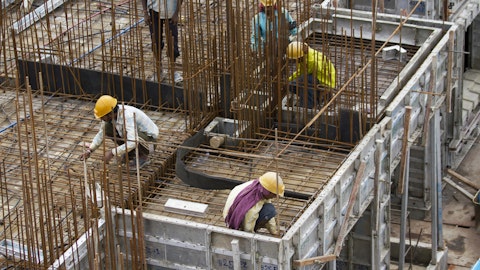Sterling Infrastructure, Inc. (NASDAQ:STRL) Q3 2023 Earnings Call Transcript November 7, 2023
Operator: Greetings, and welcome to the Sterling Infrastructure Third Quarter 2023 Conference Call and Webcast. [Operator Instructions]. It is now my pleasure to introduce your host, Noelle Dilts, Vice President of Investor Relations and Corporate Strategy. Thank you. You may begin.
Noelle Dilts: Thank you, Joanna. Good morning to everyone joining us, and welcome to Sterling Infrastructure’s 2023 Third Quarter Earnings Conference Call and Webcast. I’m pleased to be here today to discuss our results with Joe Cutillo, Sterling’s Chief Executive Officer; and Ron Ballschmiede, Sterling’s Chief Financial Officer. Joe will open the call with an overview of the company and its performance in the quarter. Ron will follow that up with the detailed discussion of the financial results. After which Joe will provide a market and full year outlook. Then we will open the call up for questions. As a reminder, there are accompanying slides on the Investor Relations section of our website. Before turning the call over to Joe, I will read the safe harbor statement.
Some discussions made today may include forward-looking statements. Actual results could differ materially from the statements made today. Please refer to Sterling’s most recent 10-K and 10-Q filings for a more complete description of risk factors that could affect these projections and assumptions. The company assumes no obligation to update forward-looking statements as a result of new information, future events or otherwise. The financial information herein and discussions are related to the company’s continuing operations. Please also note that management may reference EBITDA, adjusted EBITDA, adjusted net income or adjusted earnings per share on the call, all — which all are financial measures not recognized under U.S. GAAP. As required by SEC rules and regulations, these non-GAAP financial measures are reconciled to their most comparable GAAP financial measures in our earnings release issued yesterday afternoon.
I’ll now turn the call over to our CEO, Joe Cutillo.
Joseph Cutillo: Thanks, Noelle. Good morning, everyone, and thank you for joining Sterling’s third quarter 2023 earnings call. I’d like to thank our Sterling team for another record quarter. Their hard work and dedication has allowed us to deliver 11 quarters of consecutive year-over-year net income growth. Our diluted earnings per share for the third quarter were $1.26. This represents a substantial 25% increase compared to our same period in 2022, and surpassed our internal projections. Revenue growth in the quarter was 13.7% or 11.7% on an organic basis. Demand trends across our key markets remain strong. The best reflection of this is our backlog, which is up 42% from the beginning of the year and totaled over $2 billion.
Our cash flow generation remains excellent. Operating cash flow in the quarter was $150 million, bringing our total cash position to $409 million at the end of the quarter. Our focus remains on deploying our cash into acquisitions that complement our current offerings and enhance our competitive position. We have intensified our targeting efforts and remain extremely active on this front. As we continue to expand our business both organically and through strategic acquisitions, we remain unwavering in our adherence to our guiding principles, the Sterling Way. These principles underscore our commitment to take care of our people, our environment, our investors and our communities, while we work to build America’s infrastructure. With a strong third quarter performance, year-to-date results, backlog position and visibility into the fourth quarter, we are raising our full year guidance.
The midpoint of our increased earnings per share guidance would represent a 32% growth over 2022. Moving to our segments. E-Infrastructure Solutions backlog grew 48% from the beginning of the year to a new record of $891 million. We continue to see a strong pipeline of work related to data centers and onshoring of manufacturing. We currently have line of sight into several large projects slated to bid in 2024 and 2025 in both of these markets. In the quarter, we did see a slight decline in Infrastructure Solutions revenue and margins relative to prior year. This was driven by timing of several new project starts and the continued softness in e-commerce distribution centers and small warehouses in the Northeast. Our Southeastern operations continued to show strong growth and margin expansion as we execute on large manufacturing and data center projects.
The early start of large manufacturing projects in the Southeast has allowed the region to more than offset the softness in e-commerce distribution in small warehouses. This has not yet been the case in the Northeast, where we are just seeing the first large manufacturing opportunities emerge. In Transportation Solutions, revenue increased nearly 23% year-over-year and 28% sequentially. We are seeing very strong demand and margin growth across our entire geographic footprint. Awards in the quarter of $472 million drove backlog growth of 14% from the beginning of the year. Though the majority of backlog growth year-to-date is attributable to the highway market. Aviation bid activity has picked up significantly, and we expect to hear final decisions on several projects in the fourth quarter.
Transportation Solutions margin expanded 130 basis points driving a 49% growth in operating income. Operating margins reached a new high of 7.5%. We believe we have an opportunity to continue to increase margins as long as the market remains robust. This is supported by the improving margin profile in our backlog. In Building Solutions, we grew revenue 41% or 29% on an organic basis. On the residential side, we continued to significantly outperform the national market. Our revenue growth was 52% compared to an average increase of 7% for single-family home starts nationally in the third quarter. We remain confident that the dynamics in our markets and our strong customer relationships will drive sustained outperformance. Continued strong demand in multifamily and attractive margin opportunities enabled us to grow our commercial revenues by nearly 23%.
Building Solutions operating profit margins remained strong at 11.3%, driving income growth of 38%. With that, I’d like to turn it over to Ron to give you more details on the quarter. Ron?

Ronald Ballschmiede: Thanks, Joe, and good morning. I am pleased to discuss our third quarter performance. Let me take you through our financial highlights, starting with our backlog metrics. At the end of the quarter, our backlog totaled a record $2.01 billion, an increase of $596 million at the beginning of the year. The gross margin of this backlog was 15.2%, a 90 basis point improvement from the beginning of the year. Higher Transportation and E-Infrastructure backlog margins drove this improvement. Unsigned Awards at the end of the third quarter totaled $375 million. Substantially all of our Unsigned Awards relate to our Transportation Solutions segment. We expect to have the majority of Unsigned Awards to move into backlog by the end of the year.
We finished the quarter with combined backlog of $2.386 billion, a $696 million increase from the beginning of the year. Our gross margin in the combined backlog was 14.9%, an increase of 70 basis points from the beginning of the year. The 14.9% gross margin is the highest level in Sterling’s history. Our year-to-date backlog book-to-bill ratio was very strong 1.5x for both backlog and combined backlog. Revenue for the current quarter was $560 million, up $67 million over the 2022 quarter. As a result of our strong backlog and our opportunities across each of our markets, our updated increased full year revenue guidance is now between $1.99 billion and $2.05 billion. Consolidated gross profit was $92 million in the quarter, an increase of $12 million over the prior year period.
Gross margins increased to 16.4% or 30 basis points over the prior year quarter. General and administrative expense was $25 million for the quarter, an increase of $3 million when compared to the same quarter of the prior year. The increase was driven by general inflation, increased revenue-related incremental costs and G&A related to the late 2022 Arizona Slab acquisition. We continue to expect our full year G&A expense to be approximately 5% of revenues. Operating income for the quarter was $57 million, an increase from $49 million or 15% over the prior year quarter. Our third quarter operating margin increased to 10.2% from 10% in the third quarter of 2022. Our effective income tax rate for the third quarter was 25.7%. Our tax rate benefited from increased tax deductions related to stock-based compensation.
We continue to expect our full year 2023 effective income tax rate to be approximately 27%. The net effect of all these items resulted in record third quarter net income of $39.4 million or $1.26 per diluted share compared to $30.7 million or $1.01 per diluted share in the third quarter of 2022. With our year-to-date 2023 strong performance and the strength of each of our key markets, we have increased our full year 2023 net income guidance to $128 million to $130 million — $132 million. Our EPS guide is now $4.10 to $4.23 per diluted share from our prior EPS range of $4 to $4.20 per diluted share. EBITDA for the quarter totaled $71.2 million, an increase of 16% over the prior year quarter. EBITDA margins improved to 12.7%, up from 12.5% in the prior year quarter.
Our updated 2023 guidance for EBITDA is now $252 million to $260 million for the year. Our consolidated cash balance increased by $228 million from the beginning of the year to $409 million at the end of the third quarter. Our cash balance exceeds our total debt of $358 million by $51 million. Cash flow from operating activities for the 9 months ended September 30, ’23 was a very strong $331 million compared to $138 million in the prior year period. The operating cash flow improvement was driven by the significant organic growth of each of our segments as well as favorable improvements in our working capital. Cash used in investing activities was $25.6 million for the 9 months ended September 30, ’23 compared to $47.8 million for the 2022 period.
The decrease was driven by the timing of net capital expenditures, offset by first quarter receipt of $14 million from the late 2022 Myers divestiture. We expect full year capital expenditures to be $50 million to $55 million, reflecting the strong organic growth of our E-Infrastructure Solutions segment. Cash flow from financing activities was an $81 million cash outflow for the 9 months ended September 30, 2023, primarily from debt repayments of $77 million. The debt reductions include voluntary early debt payments totaling $53 million. Considering the diversity and strength of our portfolio of businesses, our strong liquidity position and our very comfortable EBITDA leverage, we are well prepared to take advantage of additional opportunities in 2023 and beyond.
Now I’ll turn the call over to Joe.
Joseph Cutillo: Thanks, Ron. As we sit here today, there appears to be no end in sight to the growing need to build and revitalize America’s infrastructure. We play a critical role in building the manufacturing plants that are reshoring production to the U.S. The data infrastructure that enables today’s way of life, the highways, the bridges and the airports that connect this and the homes we live in. In E-Infrastructure Solutions, we continue to see a robust pipeline of large manufacturing projects tied to electric vehicles, batteries, semiconductors and pharma, both in our current footprint and other potential geographies. We anticipate continued strength in data centers as current capacity represents only a fraction of what will be needed to support artificial intelligence and other emerging technologies.
We believe that the e-commerce and small warehouse markets will remain soft through 2024, but pick back up in 2025. These dynamics support strong growth opportunities over a multiyear period for E-Infrastructure solutions. In Transportation Solutions, we think we’re now in a market environment where we can accelerate growth relative to historical levels as long as margins remain at current levels or higher. In Building Solutions, we continue to see strong residential activity in our markets and our customers remain bullish as we enter into 2024. In addition, multifamily starts to remain robust and margin opportunity is strong. With our very healthy cash flow and balance sheet, we continue to look hard at acquisitions in E-Infrastructure and Building Solutions.
We’re proud of how far we’ve come, but even more excited about the opportunities ahead of us. We believe that the build-out of the U.S. infrastructure will remain strong over the next 3 to 5 years. With our visibility into the fourth quarter in a record backlog, we are confident in our increased guidance and are positioned for an even better 2024. With that, I’d like to turn it over for questions.
See also Top 20 Most Valuable Esports Companies and Where Should You Invest $1000 Right Now?.
Q&A Session
Follow Sterling Infrastructure Inc. (NASDAQ:STRL)
Follow Sterling Infrastructure Inc. (NASDAQ:STRL)
Receive real-time insider trading and news alerts
Operator: [Operator Instructions]. First question comes from Brent Thielman at D.A. Davidson.
Brent Thielman: I guess first question, Joe, you talked about it a bit in the closing comments there, but this sort of drag from the e-commerce projects, some of the steps in the Northeast, you mentioned it will carry through 2024. How should we think about that impacting your ability to get the E-Infrastructure business still to those kind of long-term compound growth rates you talked about for the business, I guess, the 9% to 12%?
Joseph Cutillo: Yes. We’re still — Brent, we’re still confident in those numbers. Let me explain in a little more detail what happened in the second quarter because there’s really a couple of parts of that. On the positive side, we had great weather in the second quarter. Teams are running hard, and we actually finished some projects that would have been anticipated to finish in the third quarter a little early in the second quarter. So our second quarter numbers were fantastic. What we tried to do is get other jobs kicked off earlier in the third quarter, and we had a combination of one, that not happening, and two, jobs that have actually pushed out to start later. So you got a little bit of a double whammy just in the Northeast that, that happened.
So that’s where the lion’s share of the revenue drop was. Actually, all of the revenue drop was there. And as a result, we got a little bit of an impact on indirect absorption and those sort of things relative to our normal run rate. As we look forward, it’s not that the e-commerce distribution centers definitely, Amazon has slowed down. We normally have five Amazons going at any given time. We’ve got one right now. And we continue to — we think that’s not going to pick up according to Amazon until the small warehouse activity is really the private side, which is a little bigger piece of the market up in the Northeast and the Southeast, and that softened with some of the financing. However, what we’ve seen, the biggest difference is when you look at the Southeast, we originally anticipated manufacturing jobs, not kicking off until ’24, ’25.
The good news is in the Southeast, those jobs have kicked off quicker. In the Northeast, those jobs are in the early stages of being launched and released. The difference between us growing at high single digits to what I’ll call strong double digits is really literally landing one or two of those jobs. I will tell you that we’ve got line of sight to three to five of those jobs as we sit here today going into ’24 and ’25. And we feel confident we’ll land our fair share of those and we’ll be in good shape once those big projects kick in to the Northeast. The Southeast continues to grow at kind of strong rates, and it’s really a lag of the big projects in the Northeast.
Brent Thielman: Okay. That’s helpful, Joe. And yes, I guess the large project that you mentioned, plan to bid ’24, ’25. Are these as biggest the record booking that you recently announced, just looking maybe for a little more context relative to that or just to see the year-to-date, Joe.
Joseph Cutillo: Yes. These are — these projects are in total multibillion-dollar projects, just like the ones we’re doing now. Obviously, they vary in size to some degree on our scope. But these are large projects, Brent. The other thing to keep in mind is our backlog position right now is up 40 something percent over beginning of the year, we’re in a very good, very strong backlog position. So I would tell you, don’t let a quarter or two of dip kind of take over the narrative of what the real growth and real opportunity is up there and where we’re at with it.
Brent Thielman: Yes. Understood. And then on Building Solutions, I mean, pretty solid growth here considering the environment, you were more optimistic as the year sort of developed around that business. Certainly things have picked up. But I guess with mortgage rates continuing to climb, is that having any impact on the KPIs that you sort of track internally slab growth rates, et cetera? Just any measure you’d point to that positivity there in light of that.
Joseph Cutillo: Yes. I mean everything it’s — what I would reflect back and say the strategy we put together a couple of years ago for the downturn is really paying off. As we’re able to not only take advantage of growing markets, but we’ll continue to grow market share in the Houston and Phoenix market to offset those declines in total. But we’re seeing both of those markets remain — including Dallas, they all remain strong. It’s working. We’re outperforming the general market by a factor of a lot, right? So that’s been very good. The only thing we’ve seen that I think is encouraging to us is we have definitely seen the size of slabs decrease. So what that means is we have to do more slabs to get the same revenue. The nice thing is — if we look at the margins on those slabs versus the older larger slabs, we’ve been able to hang in there on the margin side.
Brent Thielman: Okay. Commercial I mean this is just…
Joseph Cutillo: Commercial — yes, on the commercial, I always forget to talk about commercial because it’s normally such a small piece of our business. But we’ve seen very nice margin growth and very nice opportunities there. If you remember, a couple of years ago, we shrunk that commercial business down to I’ll call it, a small skeleton of what it is today. But the margins remain strong and the activity on multifamily remains very strong in the markets we’re at, and that was up 20-something percent.
Brent Thielman: Got it. Just the last one to — I mean, the huge cash generation again this quarter and year-to-date, it looks like you’re benefiting from pretty large advanced payments. Does that all reverse in a material way in 2024 where we see sort of cash flow more consistent with kind of your historical conversion rates?
Ronald Ballschmiede: Certainly, on a project by project, it will, although our largest project is still more than four quarters work to do. What — obviously, we expect to happen are some of these large jobs starting up with the same characteristics, frankly, of cash flow and this work on just the timing of billings and collections. So I don’t see actually variability, which we have across the board in each of our large contractor segments of transportation and the infrastructure. But I think it will stay kind of on the favorable side for quite some time with these big projects out there. We’re pretty much plateau, no pun intended at this point in time. I don’t see them coming down dramatically.
Operator: The next question comes from Brian Russo at Sidoti.
Brian Russo: Can you just remind us — I know there are some margin differences between Plateau in the Southeast in Petillo in the Northeast, it could be union versus nonunion or labor force and/or just scope of work? Just trying to get a sense of as the activity ramps up in the Northeast, you can still maintain the margin profile that you’ve gotten mostly on the hyperscale data center and reshoring down in the Southeast?



